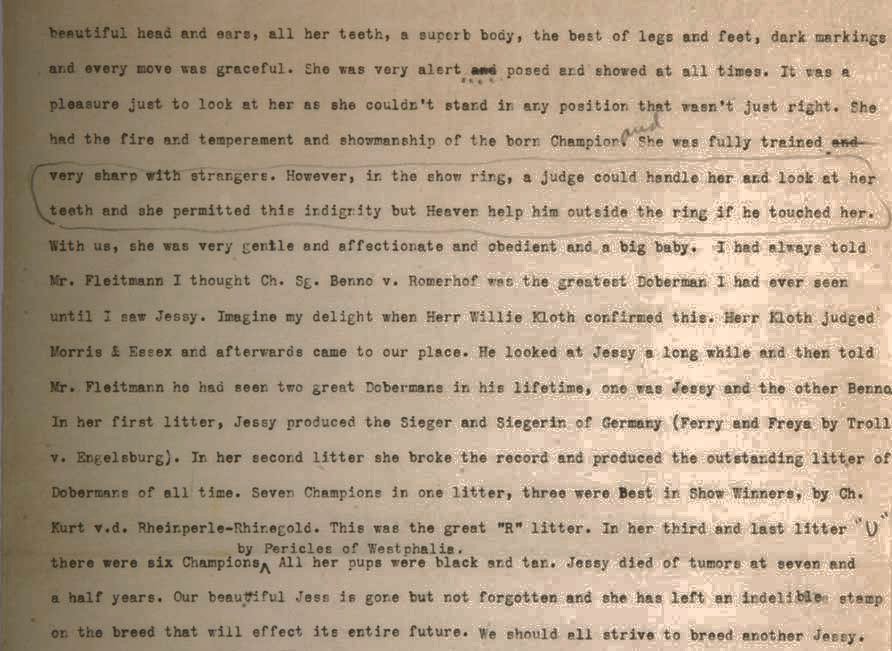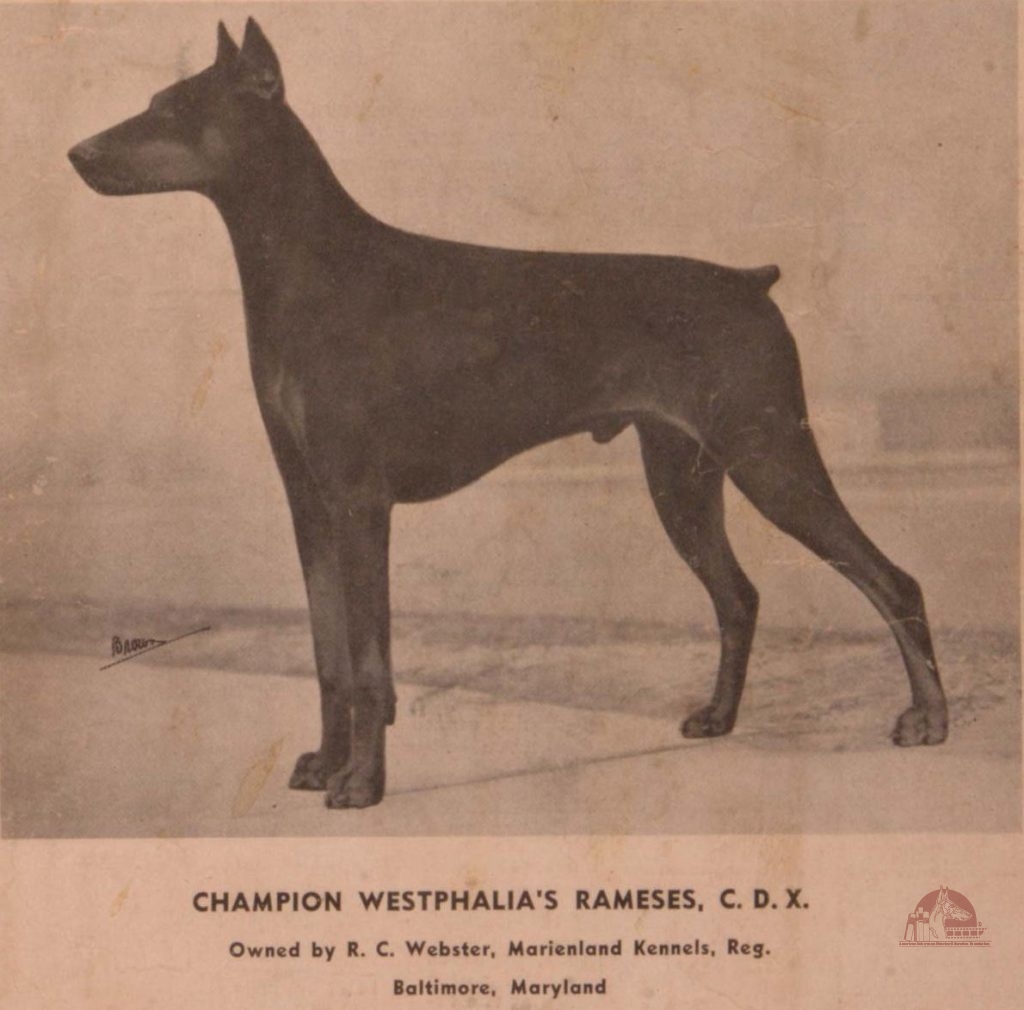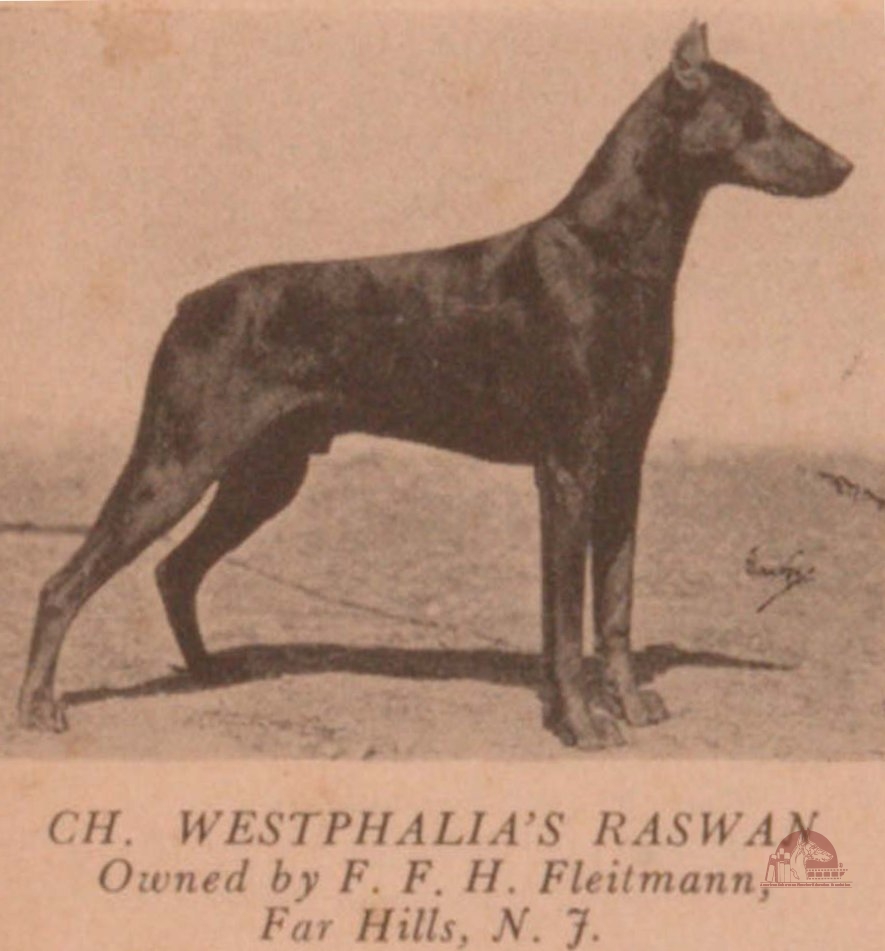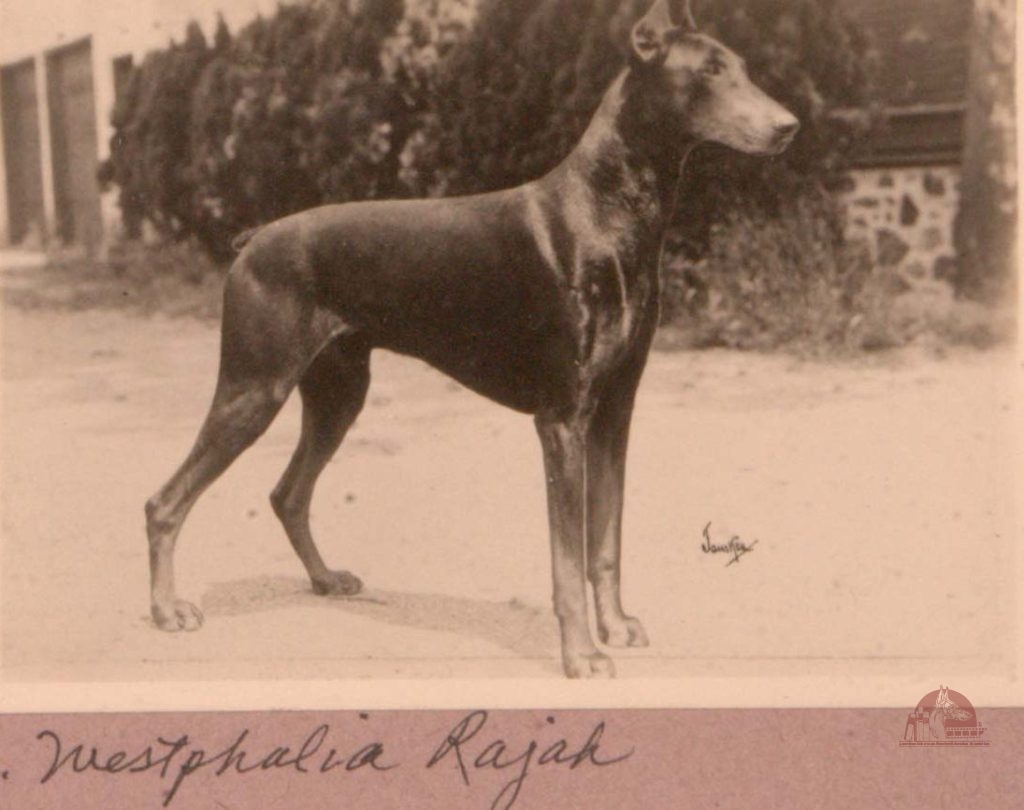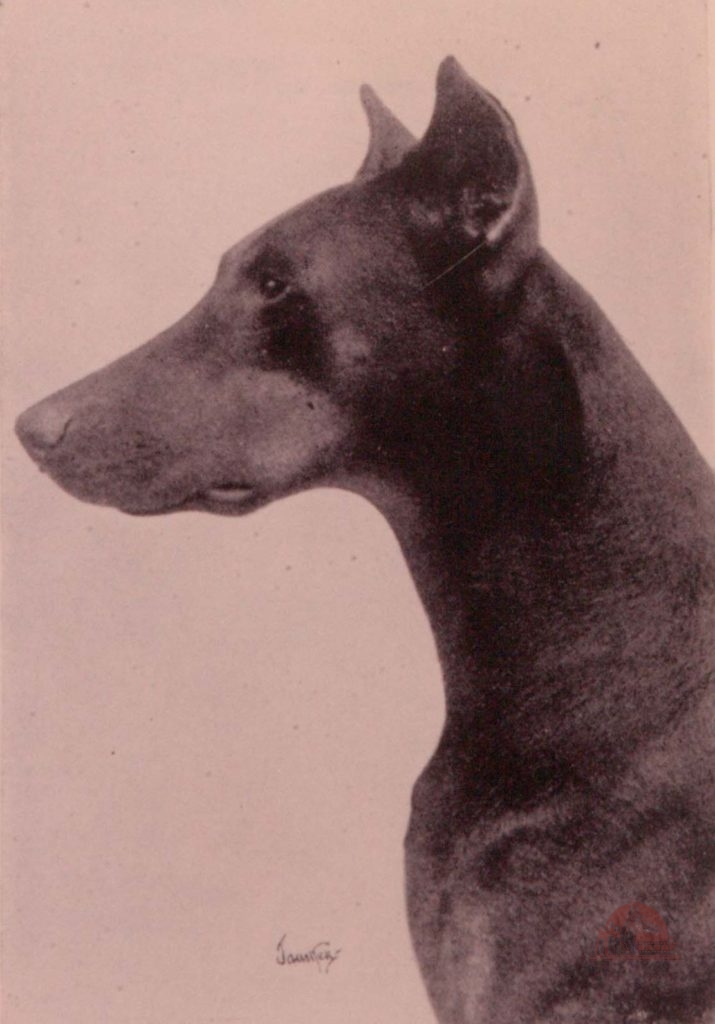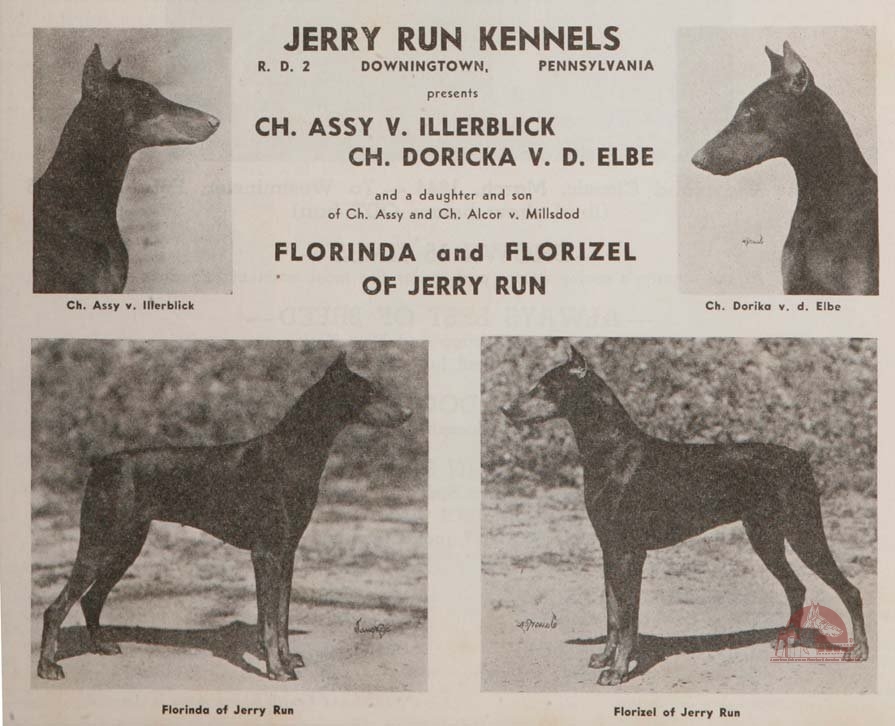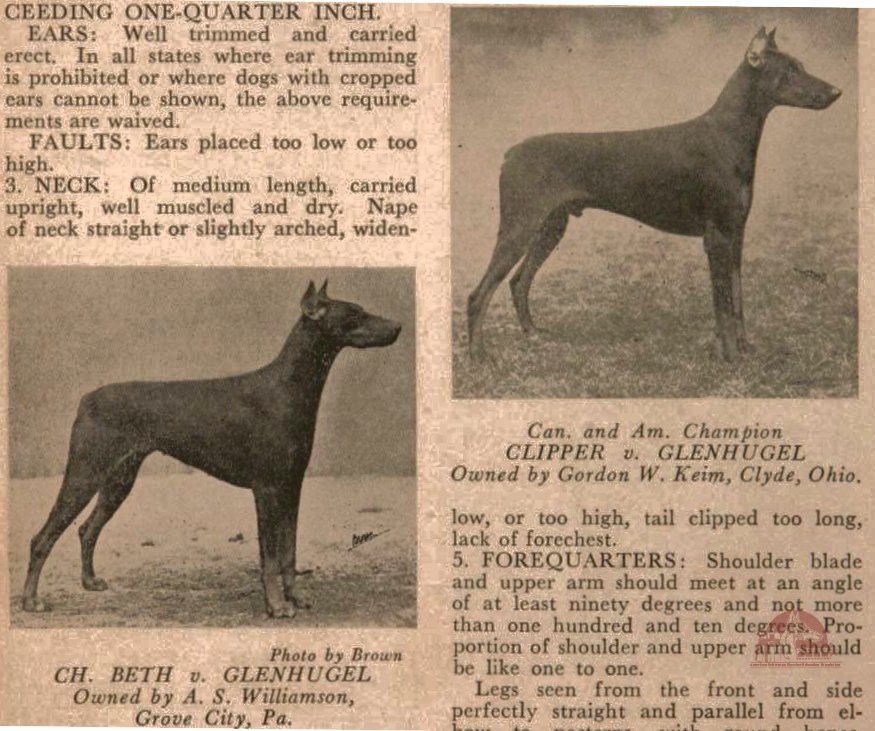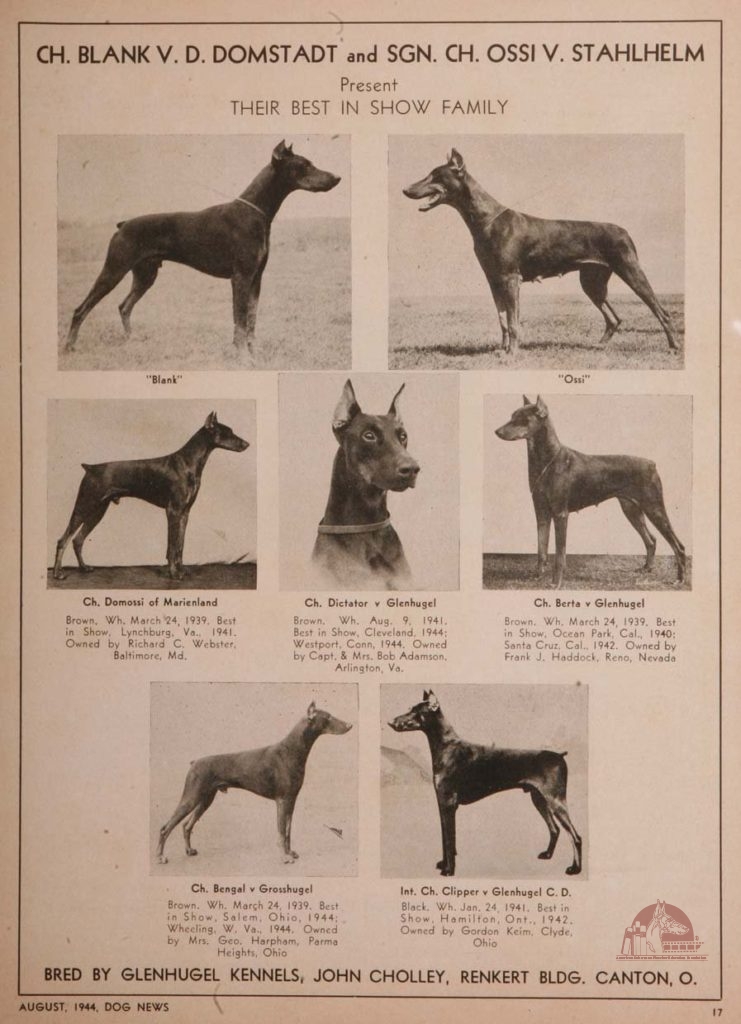Margi Bragg, Historian for the ADPEF, has researched our files extensively and written about the FIVE dogs that are the foundation of our current American Dobermans.
Her perspective, shown below, illustrates that all modern American bloodlines can be traced back to the breedings of Blank to Ossi and Kurt to Gretl and Kurt to Jessy. Their influence was not only dramatic, but was planned by a handful of dedicated breeders that sought to save the best of the German dogs and preserve the heritage of the breed in America.
All breeders need to know the origins of their breeding stock to in order to plan for the future.
Ch. Cherloc v Raufelsen
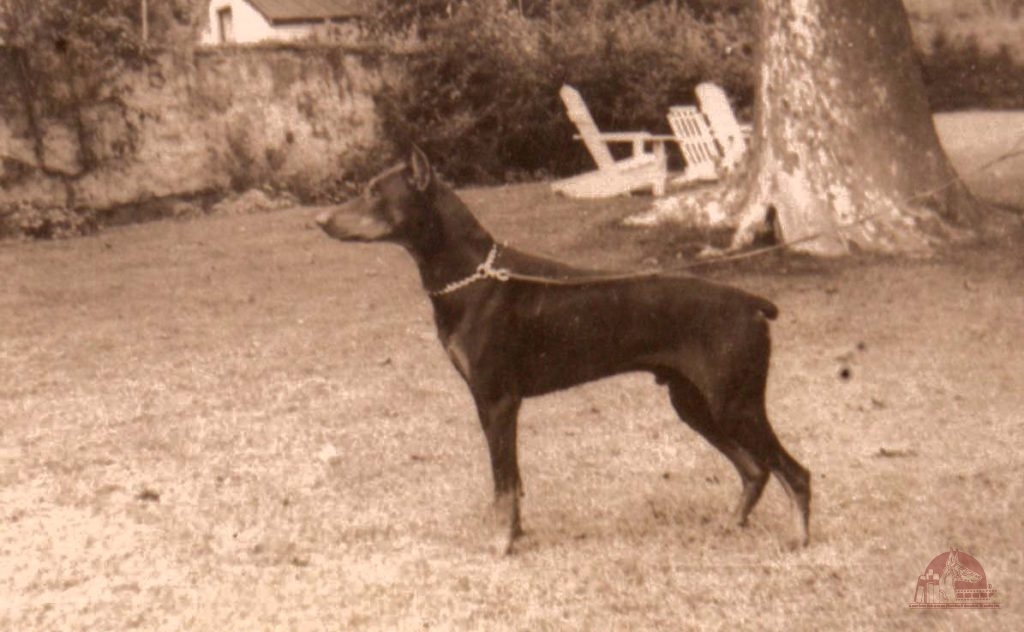 Never was a dog used less to produce more. Cherloc was born in Germany Feb. 28 1932, and by 1939 had been sold to Italy. I have no record of exactly how many litters he sired in Germany before he left, but it is enough that he sired at least two. His two daughters, Gretl v Kienlesberg (black, b. 1934), and Jessy vd Sonnenhoehe (black b.1934) formed the most lasting dynasty in Doberman pedigrees today.
Never was a dog used less to produce more. Cherloc was born in Germany Feb. 28 1932, and by 1939 had been sold to Italy. I have no record of exactly how many litters he sired in Germany before he left, but it is enough that he sired at least two. His two daughters, Gretl v Kienlesberg (black, b. 1934), and Jessy vd Sonnenhoehe (black b.1934) formed the most lasting dynasty in Doberman pedigrees today.
Cherloc was purchased by Eleanor Carpenter of Jerry Run Kennels in 1941. By the time he arrived he was sterile. A comment on Mrs. Carpenter’s love for the dog, however, is that he lived out his life at Jerry Run, and was her constant companion. Mrs. Carpenter had also imported Gretl’s German born daughter, Assy v Illerblick, and tried to breed her back to her grandfather many times. It is interesting to note that Assy’s brother, Ajax v Ilerblick is the grandfather of Alex v Klienwaldheim, the dog the German’s credit with saving the breed in Europe after the war, making Cherloc’s influence equally strong in Europe today.
It is an interesting aside that within a month of Cherloc’s arrival, Ch. Dow’s Cora v Kienlesberg, Gretl’s daughter, had been bred to him, and John Zimmerman (Kurt’s owner), Bert Dow (Gretl’s owner), and John Cholley (Blank and Ossi’s owner), had all reserved puppies.
Ch. Gretl v Kienlesberg
 Gretl was considered a great show bitch, finishing her American championship very quickly, with breeds and group placements. As a mother, she had left Ajax v Illerblick in Germany, who proved to be a good sire.
Gretl was considered a great show bitch, finishing her American championship very quickly, with breeds and group placements. As a mother, she had left Ajax v Illerblick in Germany, who proved to be a good sire.
In this country, soon after she finished her championship, she was bred to Ch. Kurt vd Rheinperle-Rheingold, as was her half sister Jessy. Disaster ensued and Gretl, along with most of her litter, died of distemper. Only two bitches could be saved, Champions Dow’s Cassie and Ch. Dow’s Cora v Kienlesberg. The rule of two, going back to Cherloc, was to follow Gretl’s get.
After spectacular show careers, both bitches were bred, Cora to Ch. Westphalia’s Ramses (Jessy’s son) twice, and Cassie to Domossi (Blank x Ossi). Although Cora had several successes in her F litter, it was her two daughters, Ch. Dow’s Illena of Marienland and Ch.Dow’s Illisa of Westphalia that again carried on. A third, Isolde, was at least pointed, but I can find no further mention of her. Dow’s Invincible belonged to a Dr. Roland in Hollywood. There was one named Ivan, and Dow’s Igor of Jerry Run. Soon Cora too, would die. Cassie alone beat the family curse. Cassie produced Champions Dow’s Dusty, Dodie, and Dossi, as well as the two non-champions Ditty and Deedo, both of whom produced champions. Ditty in particular was the dam of Meadowmist Isis of Ahrtal, the foundation bitch for Tess Henseler, and dam of seventeen champions. Cassie figures heavily into Virginia Knauer’s Meadomist Kennels, Cora and Cassie into Marj Kilburn’s, Dow’s and Marienland .
Ch. Assy v Illerblick
 Ch. Assy v Illerblick, Gretl’s German daughter, ironically by a Blank son (Moritz), also made the journey to America. Eleanor Carpenter, of Jerry Run purchased her with her grandfather Cherloc, having it specifically in mind to breed them to each other. Cherloc’s sterility would change her plans, and she would eventually be bred instead to Ch. Westphalia’s Ramses (1943)”D”, Ch. Westphalia’s Uranus (1944)”E”, and Alcor (1944)”F”, producing champions from all three litters.
Ch. Assy v Illerblick, Gretl’s German daughter, ironically by a Blank son (Moritz), also made the journey to America. Eleanor Carpenter, of Jerry Run purchased her with her grandfather Cherloc, having it specifically in mind to breed them to each other. Cherloc’s sterility would change her plans, and she would eventually be bred instead to Ch. Westphalia’s Ramses (1943)”D”, Ch. Westphalia’s Uranus (1944)”E”, and Alcor (1944)”F”, producing champions from all three litters.
Jerry Run bitches produced champions for many other breeders all over the country, including Elblac, and Gra-Lemor. Never much of a self-promoter the influence of Jerry Run is easy to overlook. Mrs. Carpenter wrote educational articles, was a strong and reliable presence in the DPCA, a respected judge, and held in high regard by all who knew her.
In the 1950’s, her beautiful kennel and 500 acres in Pennsylvania was seized by eminent domain for a recreational park, and Mr. and Mrs. Carpenter had to move. Jerry Run was dispersed, and some of the purest and most perfectly line-bred of the Holland bloodline was gone.
Incidentally, Mrs. Carpenter was fascinated by blues, and bred the first blue Champion in America, a descendant of both Rameses and Rajah.
Ch. Kurt vd Rheinperle-Rhinegold
 The story of Kurt is an amazing one, as he was a dog that was bred by a committee. As told by Peggy Adamson for the January 1944 Western Kennel World. “There is an interesting story behind Kurt. John Zimmerman says he felt that in America we were getting too much same strain inbreeding and in a desire to dilute such intensity, he told Herr Willi Bauman that he wished to buy a male or two without the slightest bit of Sigalsberger blood. Herr Bauman was in America at the time to judge the 1930 D.P.C.A. Specialty.
The story of Kurt is an amazing one, as he was a dog that was bred by a committee. As told by Peggy Adamson for the January 1944 Western Kennel World. “There is an interesting story behind Kurt. John Zimmerman says he felt that in America we were getting too much same strain inbreeding and in a desire to dilute such intensity, he told Herr Willi Bauman that he wished to buy a male or two without the slightest bit of Sigalsberger blood. Herr Bauman was in America at the time to judge the 1930 D.P.C.A. Specialty.
Some months after he returned to Germany, Mr. Zimmerman received a letter from Herr Willi Kloth of Aachen, Germany, saying that Herr Bauman had told him what he wished to buy-was he still of the same desire? In the meantime Herr Bauman had written that Herr Jacob Brunner in Dusseldorfhad a red bitch, Anita zur Immermannhoehe, she without any Sigalsberger blood.
Then these three German breeders, two of them high- ranking judges of the breed, located a male, Astor of Westphalia, over in the Ruhr country who was also without any Sigalsberger blood. Well, the arrangements were made for the mating of Astor and Anita and it was a full year after Herr Bauman had left America before the litter was whelped in December, 1931.
From this original litter of seven, Kurt and Karlo, as well as their dam, Anita, made the long trip to America, arriving in Detroit in August 1932. Karlo was a sick dog, dying two years later, but his dam, Anita lived to be nine years old.
John writes: “In reality, Kurt was made to order. Kurt has established the world record as the sire of more champions than any other Doberman stud dog. He was a grand champion, house dog; and if necessary- would take a hold on any intruder. As a show dog he was so-so.”
(Editors note: It is a great credit to Peggy that she wrote this story at all, since the Sigalsberger blood in question was that which produced her very own Dictator.)
“His daughter, Ch. Dow’s Cassie, in her first litter by Domossi produced the outstanding current winner, Ch. Dow’s Dodie; and two more from the same litter, Dossi and Dusty are well along to the title. Cassie is Kurt’s only living daughter out of Gretl. Her only litter sister, the late Ch. Dow’s Cora produced by Rameses, Ch. Dow’s Illena and her two litter sisters Isolde and Illisa, who are near the title.”
Kurt went on to produce ten more champions from six more bitches, but his real worth was noted when bred to Sgrn. and Ch.Jessy vd Sonnenhoehe, they produced a whopping seven champions, more than in any litter of any working breed. Champions Westphalia’s Rameses, Rajah, Raswan, Rani, Rembha, Roxanna, and Ramona.
Not only did these finish, many of them finished with groups and BIS, Rembha, Rameses, and Rajah having fantastic show careers. Interesting to note is that Rameses had been sold at a pet price, as it was felt he was not show quality. He was the first of the group to achieve great success as a sire.
Kurt then proved he could produce in the second generation, when his son Pericles sired Jessy’s next litter—six champions; Uganda, Ursula, Umbra, Undine, Jessy, and Ch. Westphalia’s Uranus. In all Jessy produced thirteen champions from seventeen puppies. Not bad for Kurt, a dog that was “indifferent” (P. Gruenig) as a show dog.
Sgrn and Ch. Jessy vd Sonnenhoehe

Born in 1934, Jessy was a marvel in every way. She was the first to win the Sieger show twice, although she did not become Siegerin the first time because of her lack of a working title (1936 and1937). She was the only dog to produce a Sieger (Ferry) and Siegerin (Freya) in the same litter (1938). American breeders, F.F.H.Fleitmann, Howard Mohr, and Eleanor Carpenter, had been hearing from friends in Europe about their concern for the dogs should war break out, made a trip specifically to purchase as many good dogs as possible. Mr. Fleitmann must have known what a great bitch she would be for Westphalia if bred to Kurt, son of his Astor. Jessy had exactly the breeding he wanted, that of Helios. Mr. Fleitmann had stated many times that the blood of Helios must be preserved at all costs.
By the end of 1937 Jessy had finished her American Championship with several spectacular wins, and by 1940 the first three of her American born puppies had finished. Freya and brother Frido (out of Troll vd Engelsberg) went on to become producers in Germany, son Ferry was purchased by Geraldine Dodge’s Giralda Farms specifically to win the Garden, and win it he did, but Ferry is another story, although he did contribute to Jessy’s champion grandchildren.
I found a wonderful letter from Ellie Buckley (Westphalia kennel manager) to Vivian Edwards describing Jessy:
Ch. Blank vd Domstadt and Sgrn and Ch. Ossi v Stalhelm
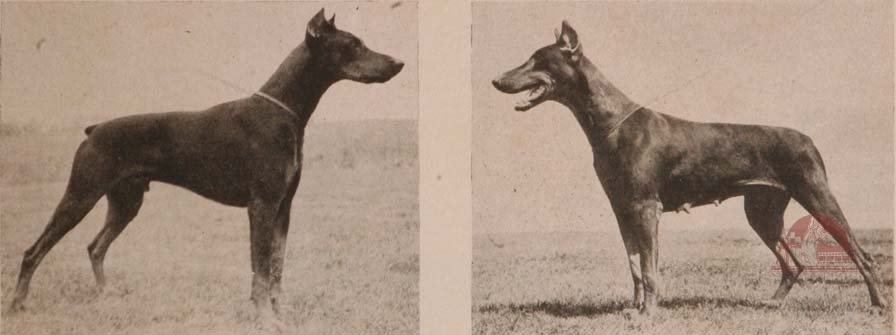 Blank and Ossi are almost inseparable. Although Blank was bred to other bitches with great results, all of Ossi’s puppies were by Blank, and became, with continued line-breeding, the cornerstone of the Doberman in America.
Blank and Ossi are almost inseparable. Although Blank was bred to other bitches with great results, all of Ossi’s puppies were by Blank, and became, with continued line-breeding, the cornerstone of the Doberman in America.
Ossi is frequently viewed as a brood bitch, but in truth she was the show dog of the pair, being first the red Seigerin in 1937 (Jessy was the black Siegerin that year), and then finishing her American championship within weeks of arriving, with group placements.
Blank was born in 1934-what a year-and Ossi in 1935. Ossi was not shown further, but was immediately bred. She is listed as finishing in 1938, and her “B” litter v Glenhugel began to finish in 1940. Five champions in the “B” litter (all producers, several group winners, and at least one BIS winner) received so much attention that they almost completely over shadowed the “C” litter, Clipper, Cognac, Cleta, Carla, and Canton.
The fourth litter produced Dictator, who so completely drew attention to himself no one noticed that he had brothers and sisters (Ch. Dinah is from this litter, and a brother Dale who could not be shown due to an injury, but was used at stud, also Dapper, the pick).
The “E” litter was to follow, two black males, but I have only found reference to one, Ego, although in two different articles Peggy mentions that the breeding was done five times. Later she says six times. There was another bitch (bred but not finished) who’s name was Lady Agatha, and she was the “A” litter. Blank died at ten, accidentally poisoned, and Ossi died in January 1949, at nearly fourteen years of age, and was the last of the great imports of the thirties.
Reading the archives, it becomes patently obvious that dog people haven’t changed much in eighty years. Westphalia, Pontchartrain, and Rhinegold, believed wholeheartedly in the Holland/Helios cross, and wanted no part of the line-breeding to Muck (Alto v Sigalsburg), that Blank and Ossi founded. Glenhugel and Lindenhof saw the flaws in the Helios family. Marienland, Dow’s, Kilburn, Meadowmist and Jerry Run refused to take sides and bred back and forth. The Westphalia strain was purported to have beautiful heads, dark eyes, wonderful necks, broad and deepchests, the “right” type, and full mouths.
The Glenhugel family excelled in toplines, tailsets, temperament, and strong rears. Had either family stuck entirely to its own, the breed would have stalled and eventually split into two distinct and inferior types, but the efforts of Bert Dow, Marj Kilburn ,and Dick Webster to carefully blend the lines while always line-breeding and choosing only the best, created the “modern” Doberman. That they bred at a time when interest in the breed was skyrocketing didn’t hurt.
Within ten years, most of the pre-war bloodlines in America had faded away, and the “takeover” of the five dogs was complete. From about 1950 on, it didn’t really matter what the pedigree was, it always led to some combination and recombination of Blank to Ossi, Kurt to Jessy, and Kurt to Gretl. With many generations between now and then, American breeders can’t always see that the foundation laid down was so tiny, tight and well-built.
But for us today, selection of individuals is much more important than selection of pedigrees. This is due to the fact that the work to build families and family type was done for us from 1934 to 1950.
Modern pedigrees may be slanted to either the Jessy side or the Blank side, Ahrtal for example, is predominantly Kurt to Jessy, whereas the Damasyn dogs were more of Blank and Ossi, and the Kilburn dogs Kurt to Gretl AND Blank to Ossi, but all include the other. What has changed is the depth of commitment and sense of responsibility the breeders of the forties felt to the development of the breed. They wanted to leave behind something good. Please re-read ILLENA AND THE SEVEN SIRES by Peggy Adamson and try to see it in terms of the five ancestors. It really is amazing.


